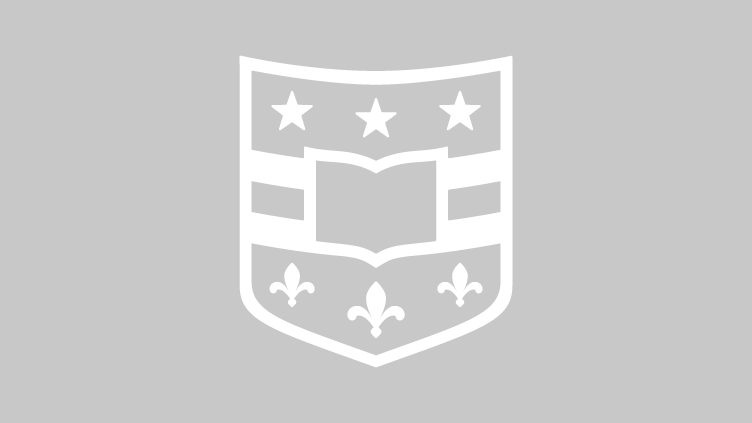Guide star lets scientists see deep into human tissue
Focusing light into a scattering medicum such as tissue has been a dream since the beginning of biomedical optics, according to Lihong Wang, PhD, WUSTL biomedical imaging expert. Previous techniques allowed light to be focused only within a millimeter of the skin. Now Wang has invented a technique called “TRUE” that uses an ultrasound guide star to allow scattered optical light to be focused deep within tissue.
WUSTL’s David Peters receives AIAA’s Reed Aeronautics Award
David Peters, PhD, the McDonnell Douglas Professor of Engineering in the School of Engineering & Applied Science at Washington University in St. Louis, has received the Reed Aeronautics Award for 2011 from the American Institute of Aeronautics and Astronautics. The Reed Award is the highest award an individual can receive for achievements in the field of aeronautical science and engineering.
Fellows of the American Institute for Medical and Biological Engineering elect two WUSTL faculty
Two Washington University in St. Louis faculty were among the 79 biomedical engineers and leaders elected this year to the American Institute of Medical and Biological Engineering College of Fellows.They are Shelly E. Sakiyama-Elbert, PhD, associate professor of biomedical engineering, and Younan Xia, PhD, the James M. McKelvey Professor of Biomedical Engineering.
WUSTL physicist debates ‘quantum mind’ at New York roundtable
Mark Alford, PhD, professor of physics in Arts & Sciences at Washington University in St. Louis, participated Jan. 29 in a roundtable discussion in New York about the quantum mind theory of consciousness. Quantum mind is a fashionable theory originally proposed by physicist Roger Penrose that grounds perception in the periodic collapse of quantum entangled electrons in our brain. Alford, who studies phenomenon that can only be explained by quantum mechanics nonetheless played the role of the skeptic in the discussion, which was videotaped and posted on the web.
Research scientists urge universities to improve undergraduate science teaching
In the Jan. 14 issue of Science, Washington University in St. Louis biologist Sarah C.R. Elgin, PhD, and 12 other biomedical research scientists recommend seven steps that universities can take to support the teacher-scientist, ranging in difficulty from educating faculty about research on learning or creating teaching discussion groups to creating (monetary) awards and named professorships for outstanding teachers and requiring excellence in teaching for promotion.
Storms, soccer matches hidden in seismometer noise
Who knew? The chance discovery that spikes in seismometer noise recorded in Africa corresponded with soccer matches has led to the discovery that there’s a lot more buried in the noise, including a signal from the famous storms of the Southern Atlantic Ocean, the bane of ships of sail.
Deep genomics: Scientists probe the epigenome
A Washington University in St. Louis team is participating in the modENCODE project, a massive ongoing effort to map all the elements in model organisms that affect whether genes are silenced or expressed. The work supports the more complex ENCODE project, which is tasked to map the same elements in the human genome. While the genome is the same in every cell, each cell type expresses a different set of genes. In people, moreover, roughly 95 percent of the genome is silenced. Together the projects will “put flesh on the bones” of the Human Genome Project, says team leader Sarah C.R. Elgin.
New method takes snapshots of proteins as they fold
Using a sophisticated version of the stroboscopic photography a pioneering photographer used in 1877 to prove that a horse takes all four hooves off the ground when it gallops, Michael L. Gross, PhD, professor of chemistry in Arts & Sciences and of medicine and immunology in the School of Medicine, catches proteins in the act of folding.
BattleBots Battle Royale
Mechanical engineering students maneuver BattleBots during a Battle Royale held Tuesday, Dec. 14. The battle was the final assignment in a freshman mechanical engineering class taught by Pat Harkins, a technical lab technician in the School of Engineering & Applied Science.
Cornstarch might have ended the Gulf spill agony sooner
Last year’s attempt to kill the Macondo well in the Gulf of Mexico by pouring heavy mud down the well bore may have been defeated by an instability that led to turbulent mixing of the oil and the mud. Jonathan Katz, PhD, professor of physics at Washington University in St. Louis, had suggested a simple solution to the problem: cornstarch. Experiments described in an article published recently in Physical Review Letters suggest his solution might have worked.
View More Stories
